服装英语论文
各国的服装英文作文

各国的服装英文作文英文:When it comes to clothing, every country has its own unique style and fashion sense. In the United States, casual wear is very popular, with jeans, t-shirts, and sneakers being a common sight. However, there are also more formal occasions that require dressier attire such as suits and dresses.In Japan, fashion is often seen as a way to express individuality and creativity. Street fashion is very popular, with young people often wearing bright colors and bold patterns. Traditional clothing such as kimonos are also still worn for special occasions.In France, fashion is seen as an art form and is taken very seriously. French women are known for their chic and sophisticated style, often wearing classic pieces such as trench coats and ballet flats. Men in France also takepride in their appearance, often wearing well-tailored suits.In China, traditional clothing such as the qipao and hanfu are still worn for special occasions, but Western fashion has also become popular in recent years. Young people often follow the latest trends, with streetwear and sportswear being popular choices.中文:说到服装,每个国家都有自己独特的风格和时尚感。
关于服装的英语作文
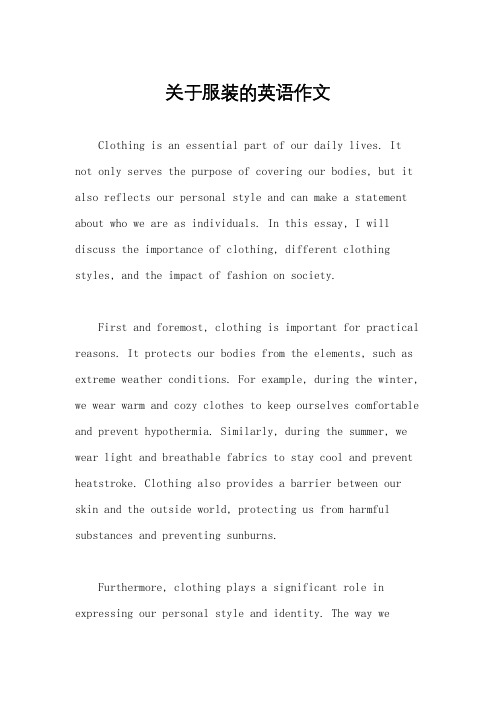
关于服装的英语作文Clothing is an essential part of our daily lives. It not only serves the purpose of covering our bodies, but it also reflects our personal style and can make a statement about who we are as individuals. In this essay, I will discuss the importance of clothing, different clothing styles, and the impact of fashion on society.First and foremost, clothing is important for practical reasons. It protects our bodies from the elements, such as extreme weather conditions. For example, during the winter, we wear warm and cozy clothes to keep ourselves comfortable and prevent hypothermia. Similarly, during the summer, we wear light and breathable fabrics to stay cool and prevent heatstroke. Clothing also provides a barrier between our skin and the outside world, protecting us from harmful substances and preventing sunburns.Furthermore, clothing plays a significant role in expressing our personal style and identity. The way wedress can reflect our cultural background, social status, and personal preferences. For instance, traditional clothing, such as kimonos in Japan or sarees in India, not only represents the cultural heritage of these countries but also serves as a symbol of national identity. Moreover, the choice of clothing can be a form of self-expression, allowing individuals to showcase their creativity and individuality.Different clothing styles have emerged throughout history and continue to evolve in modern society. Fashion trends change with time, influenced by various factors such as popular culture, celebrities, and social media. For example, in the 1920s, the flapper style became popular, characterized by short dresses, bobbed hair, and a rebellious attitude. In contrast, the 1950s saw a return to more conservative and feminine styles, with full skirts and hourglass silhouettes. Today, fashion is more diverse than ever, with a wide range of styles and subcultures coexisting.The fashion industry has a significant impact onsociety, both positive and negative. On one hand, it provides employment opportunities for millions of people worldwide, from designers and models to manufacturers and retailers. Fashion shows and events also contribute to the economy by attracting tourists and promoting local businesses. Additionally, fashion can be a form of art and creativity, inspiring individuals and pushing boundaries.On the other hand, the fashion industry has been criticized for its negative impact on the environment and labor practices. Fast fashion, characterized by cheap and disposable clothing, has led to excessive waste and pollution. Moreover, unethical labor practices, such as sweatshops and child labor, are prevalent in some parts of the industry. These issues have raised awareness among consumers, leading to a growing demand for sustainable and ethical fashion.In conclusion, clothing serves both practical and expressive purposes. It protects our bodies and allows us to showcase our personal style and identity. Different clothing styles have emerged throughout history, influencedby various factors. The fashion industry has a significant impact on society, providing employment opportunities but also facing criticism for its environmental and labor practices. As consumers, we have the power to make conscious choices and support sustainable and ethical fashion.。
有关服装的英语作文
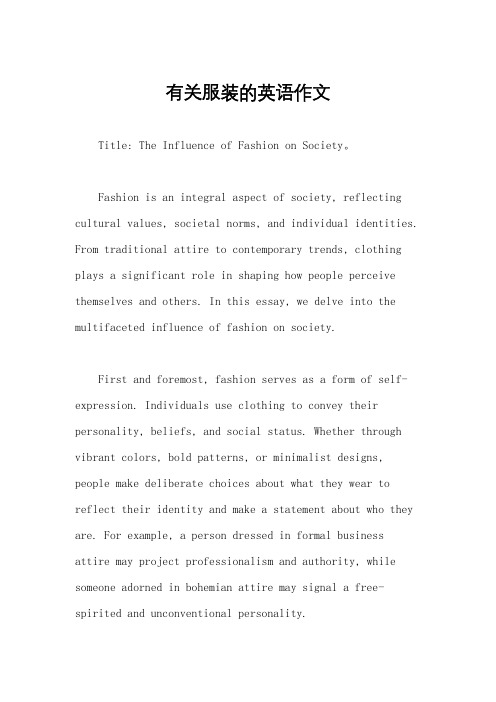
有关服装的英语作文Title: The Influence of Fashion on Society。
Fashion is an integral aspect of society, reflecting cultural values, societal norms, and individual identities. From traditional attire to contemporary trends, clothing plays a significant role in shaping how people perceive themselves and others. In this essay, we delve into the multifaceted influence of fashion on society.First and foremost, fashion serves as a form of self-expression. Individuals use clothing to convey their personality, beliefs, and social status. Whether through vibrant colors, bold patterns, or minimalist designs, people make deliberate choices about what they wear to reflect their identity and make a statement about who they are. For example, a person dressed in formal businessattire may project professionalism and authority, while someone adorned in bohemian attire may signal a free-spirited and unconventional personality.Moreover, fashion has the power to unite or divide communities. Shared dress codes and fashion trends can create a sense of belonging among like-minded individuals, fostering solidarity and camaraderie. On the other hand, disparities in fashion choices can underscore socioeconomic differences and perpetuate stereotypes. For instance, designer labels and luxury brands are often associated with wealth and privilege, widening the gap between the affluent and the less fortunate.Furthermore, fashion serves as a mirror reflecting societal values and cultural shifts. Trends in clothingoften mirror broader social movements and historical events. For instance, the rise of sustainable and eco-friendly fashion reflects growing awareness of environmental issues and the desire for ethical consumption. Similarly, the emergence of gender-neutral clothing challenges traditional notions of masculinity and femininity, promotinginclusivity and diversity.In addition, the fashion industry is a major economicforce, driving innovation, creativity, and employment opportunities. From fashion designers and seamstresses to retail workers and marketing professionals, countless individuals contribute to the production and distribution of clothing worldwide. Moreover, fashion weeks and runway shows not only showcase the latest designs but also stimulate tourism and promote local economies.However, the fashion industry also faces criticism for its environmental impact, labor practices, and promotion of unrealistic beauty standards. The production of clothing often involves the use of harmful chemicals, excessive water consumption, and the exploitation of labor in developing countries. Additionally, the portrayal of idealized body images in fashion media can contribute to body dissatisfaction and low self-esteem among individuals.In conclusion, fashion is a dynamic and influential force that shapes our society in various ways. It serves as a form of self-expression, a means of social cohesion, and a reflection of cultural values. However, it is essential to recognize both the positive and negative aspects offashion and work towards a more sustainable, inclusive, and ethical industry.Overall Word Count: 449。
中国传统服装的英文作文

中国传统服装的英文作文英文:Traditional Chinese clothing, also known as Hanfu, has a rich history and cultural significance. It is a symbol of China's traditional culture and has been worn by the Chinese people for thousands of years. Hanfu is not only a type of clothing, but also a representation of Chinese traditional values and aesthetics.One of the most famous traditional Chinese clothing is the qipao, also known as the cheongsam. It is a form-fitting dress with a high neckline and slit up the side, and it is often adorned with intricate embroidery. The qipao is a classic symbol of Chinese femininity and elegance, and it has been a popular choice for formal occasions such as weddings and banquets.Another iconic piece of traditional Chinese clothing is the hanfu, which is a loose-fitting robe with wide sleevesand a flowing silhouette. Hanfu is often made from silk or other luxurious fabrics, and it is commonly worn for traditional Chinese festivals and ceremonies. The hanfu is a symbol of traditional Chinese values such as modesty and respect for tradition.In addition to the qipao and hanfu, there are many other types of traditional Chinese clothing, each with its own unique style and cultural significance. For example, the tangzhuang is a type of traditional Chinese jacket that is often worn by men for formal occasions, and the daxiushan is a type of traditional Chinese blouse with wide sleeves that is commonly worn by women.Overall, traditional Chinese clothing is a reflection of China's rich cultural heritage and traditional values.It is a source of pride for the Chinese people, and it continues to be an important part of Chinese culture today.中文:中国传统服装,也被称为汉服,拥有丰富的历史和文化意义。
关于服装的英语作文100字大学篇
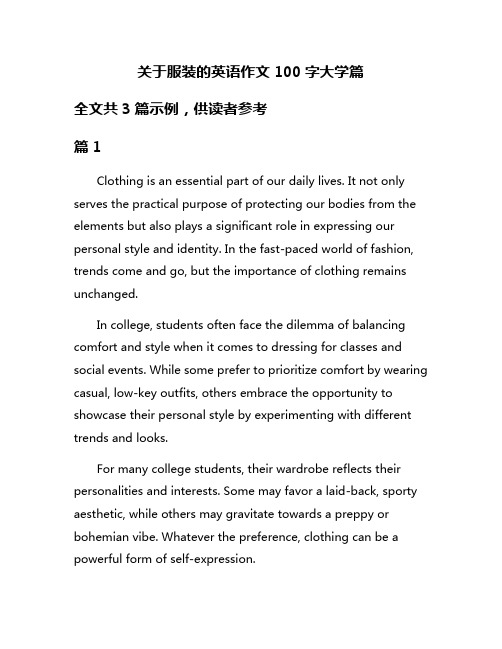
关于服装的英语作文100字大学篇全文共3篇示例,供读者参考篇1Clothing is an essential part of our daily lives. It not only serves the practical purpose of protecting our bodies from the elements but also plays a significant role in expressing our personal style and identity. In the fast-paced world of fashion, trends come and go, but the importance of clothing remains unchanged.In college, students often face the dilemma of balancing comfort and style when it comes to dressing for classes and social events. While some prefer to prioritize comfort by wearing casual, low-key outfits, others embrace the opportunity to showcase their personal style by experimenting with different trends and looks.For many college students, their wardrobe reflects their personalities and interests. Some may favor a laid-back, sporty aesthetic, while others may gravitate towards a preppy or bohemian vibe. Whatever the preference, clothing can be a powerful form of self-expression.In addition to personal style, clothing choices can also influence how others perceive us. Whether we realize it or not, our outfits send out signals to the world about our social status, cultural background, and even our mood. A well-put-together outfit can convey confidence and professionalism, while a sloppy ensemble may give the impression of carelessness or disinterest.As college students, we are at a stage in life where we are exploring our identities and figuring out who we want to be. Clothing can play a significant role in this process by allowing us to experiment with different looks and styles. Whether we choose to follow the latest trends or march to the beat of our drum, our clothing choices can shape how we see ourselves and how others see us.In conclusion, clothing is more than just fabric and thread –it is a form of self-expression, a reflection of our personalities, and a means of communicating with the world around us. As college students, we have the freedom to explore and experiment with our style, using clothing as a tool to express who we are and who we want to become. So whether you are a fashionista or a minimalist, embrace your personal style and let your clothing speak volumes about the unique individual that you are.篇2Clothing is an essential part of our daily lives. It not only serves the purpose of protecting us from the elements but also allows us to express ourselves and showcase our personal style. As college students, we often face the dilemma of balancing comfort and style when it comes to our wardrobes.One of the key factors to consider when choosing clothing for college is comfort. With long hours spent in classes, studying in the library, and participating in extracurricular activities, it is important to wear clothes that allow us to move freely and feel at ease. This means opting for breathable fabrics, such as cotton or linen, and choosing pieces that are not too tight or restrictive.At the same time, style is also important in college. Our clothing choices can make a statement about who we are and what we value. Whether we prefer a casual and laid-back look or a more polished and put-together style, our outfits can reflect our personality and individuality. It is important to find a balance between comfort and style, allowing us to feel confident and express ourselves through our clothing choices.In addition to comfort and style, practicality is also a consideration when it comes to college clothing. With a busyschedule and limited space in our dorm rooms, it is important to choose pieces that are versatile and easy to mix and match. Basic essentials, such as jeans, t-shirts, and sneakers, can be styled in different ways to create multiple outfits for various occasions.Overall, clothing plays a significant role in our college experience. By choosing pieces that are comfortable, stylish, and practical, we can feel confident and express ourselves through our personal style. Whether we are attending classes, studying in the library, or hanging out with friends, our clothing choices can make a positive impact on our overall college experience.篇3Clothing is an essential part of our daily life. It not only protects us from the elements but also expresses our personal style and identity. In college, clothing can also play a significant role in how we present ourselves to the world.For many college students, dressing for classes and social events is a way to showcase their individuality and creativity. Whether it's through stylish outfits, quirky accessories, or unique hairstyles, students often use their clothing choices to make a statement about who they are and what they value.In addition to personal expression, clothing in college can also serve practical purposes. Dressing appropriately for different occasions, such as job interviews or professional events, can help students make a good impression and advance their career opportunities. Likewise, wearing comfortable and weather-appropriate clothing can make long days of classes and studying more bearable.Furthermore, clothing can also be a source of bonding and camaraderie among college students. Shared fashion trends, shopping trips, and swapping clothes with friends can create a sense of community and connection among classmates.Overall, clothing in college is more than just a practical necessity—it's a way for students to express themselves, make a positive impression, and build relationships with their peers. By being mindful of their clothing choices, students can enhance their college experience and showcase their unique personalities to the world.。
关于服装款式的英文作文

关于服装款式的英文作文Fashion is a constantly evolving industry, with new styles and trends emerging every season. Clothing styles vary greatly depending on factors such as culture, climate, and personal preference. In this essay, we will explore some of the most popular clothing styles in the world.Firstly, let's talk about casual wear. This type of clothing is comfortable and easy to wear, and is typically worn in informal settings. Examples of casual wear include t-shirts, jeans, sneakers, and hoodies. Casual wear is popular among young people, as it allows them to express their personal style in a relaxed and comfortable way.Next, we have formal wear. This type of clothing is typically worn for special occasions such as weddings, galas, and black-tie events. Formal wear for men usually consists of a suit and tie, while women may wear a gown or cocktail dress. Formal wear is often associated with elegance and sophistication, and is designed to make thewearer look their best.Another popular clothing style is streetwear. This style is characterized by bold, edgy designs and is often associated with urban culture. Streetwear often features graphic t-shirts, oversized hoodies, and sneakers. It is popular among young people and is often seen as a way to express individuality and rebellion.Athletic wear is another popular clothing style, especially in recent years. This type of clothing is designed for physical activity and is often made from breathable, moisture-wicking fabrics. Athletic wear includes items such as leggings, sports bras, and running shoes. It is popular among people who enjoy sports and fitness, as well as those who value comfort and functionality.Finally, we have traditional clothing. This type of clothing is often associated with specific cultures and is worn for ceremonial or cultural events. Examples of traditional clothing include the kimono in Japan, the sariin India, and the kilt in Scotland. Traditional clothing is often highly decorative and may feature intricate embroidery, beading, or other embellishments.In conclusion, there are many different clothing styles in the world, each with its own unique characteristics and cultural significance. Whether you prefer casual wear, formal wear, streetwear, athletic wear, or traditional clothing, there is something for everyone. The fashion industry is constantly evolving, and new styles and trends will continue to emerge in the years to come.。
以服装为主题的英语作文

[英语作文]以服装为主题的英语作文Title: The Language of ClothesClothing is an essential part of our daily lives, serving both functional and aesthetic purposes. Throughout history, clothing has evolved to reflect cultural changes, societal norms, and personal expression. In this essay, I will explore the various aspects of clothing, including its cultural significance, the fashion industry's influence, and the importance of personal style.Firstly, clothing holds great cultural significance across the world. Different cultures have distinctive traditional garments that represent their heritage, beliefs, and values. For example, the kimono in Japan, the sari in India, and the kilt in Scotland are all symbols of cultural pride and identity. These traditional garments often have intricate designs, patterns, and colors that convey specific meanings and stories.Secondly, the fashion industry plays a significant role in shaping our perception of clothing. Designers and brands create new trends and styles that influence what people wear. Fashion weeks, celebrity endorsements, and media coverage all contribute to the widespread dissemination of fashion trends. However, the fast-paced nature of the fashion industry has also raised concerns about consumerism, environmental impact, and ethical labor practices.Thirdly, personal style is an important aspect of clothing. People use clothing as a form of self-expression, showcasing their personality, creativity, and individuality. Personal style can range from minimalist, bohemian, athletic, vintage, to streetwear, among others. It reflects one's preferences, interests, and values. Moreover, clothing choices can also communicate social status, profession, or affiliation with certain groups.Fourthly, clothing serves practical purposes beyond aesthetics. Clothing protects us from environmental factors such as weather conditions, UV radiation, and physical harm. Certain garments, such as uniforms or protective gear, serve specific functions in workplaces like hospitals, factories, or construction sites. Additionally, clothing can provide comfort and ease of movement for activities like sports, exercise, or outdoor adventures.Finally, clothing choices can have a significant impact on our confidence and self-esteem. Wearing clothes that we feel comfortable and confident in can positively affect our mood, attitude, and overall well-being. On the other hand, feeling uncomfortable or insecure about our clothing choices can lead to negativeemotions and self-consciousness.In conclusion, clothing is a complex and multifaceted aspect of our lives. It reflects cultural heritage, is influenced by the fashion industry, expresses personal style, serves practical purposes, and impacts our confidence and self-esteem. As such, it is crucial to understand the various aspects of clothing and make informed choices that align with our values, preferences, and needs. By doing so, we can embrace the language of clothes and use it to communicate who we are and how we want to be perceived by others.。
服装专业英语作文

服装专业英语作文Title: The Significance of English in the Fashion Industry。
The fashion industry is a global phenomenon that transcends borders and languages. In today's interconnected world, English has become the lingua franca of the fashion business, playing a crucial role in communication, collaboration, and innovation within the industry. In this essay, we will explore the significance of English in the field of fashion, examining its impact on various aspects of the industry.Firstly, English serves as the primary medium of communication in the international fashion arena. Fashion designers, manufacturers, retailers, and marketers from different countries often need to interact with each other to create and promote their products. Whether it's negotiating contracts, discussing design concepts, or presenting marketing strategies, proficiency in English isessential for effective communication among stakeholders. Without a common language like English, misunderstandings and miscommunications can arise, hindering the smooth operation of business activities.Moreover, English plays a vital role in facilitating global trade and commerce within the fashion industry. As fashion brands expand their reach beyond domestic markets, they need to engage with suppliers, distributors, and consumers from diverse cultural backgrounds. English enables companies to navigate the complexities of international trade agreements, negotiate deals with overseas partners, and reach out to a broader customer base through marketing campaigns and social media platforms. In essence, proficiency in English opens doors to new opportunities and markets for fashion businesses, driving growth and expansion on a global scale.Furthermore, English is indispensable in the realm of fashion education and research. Many prestigious fashion schools and universities around the world offer courses and programs taught in English, attracting students fromdifferent countries seeking to pursue careers in the industry. Professors, researchers, and scholars also rely on English to publish their findings, share insights, and collaborate on projects that advance the field of fashion studies. By embracing English as the language ofinstruction and scholarship, these institutions foster a culture of international exchange and knowledge sharing, enriching the intellectual landscape of the fashion industry.Additionally, English serves as a bridge between fashion and the digital world. With the rise of e-commerce, social media, and digital marketing, fashion brands need to communicate with consumers online effectively. English-language websites, blogs, and social media accounts allow companies to connect with a global audience, showcase their latest collections, and engage in direct dialogue with customers. By leveraging English-language content, fashion brands can enhance their online presence, build brand awareness, and drive sales across borders, tapping into the vast potential of the digital marketplace.In conclusion, English plays a pivotal role in shaping the dynamics of the fashion industry in today's globalized world. From facilitating communication and collaboration to enabling international trade and education, English serves as a cornerstone of success for fashion professionals and businesses worldwide. By embracing English as the language of choice, the fashion industry can continue to thrive and evolve in an increasingly interconnected and competitive landscape.。
服装专业英语作文
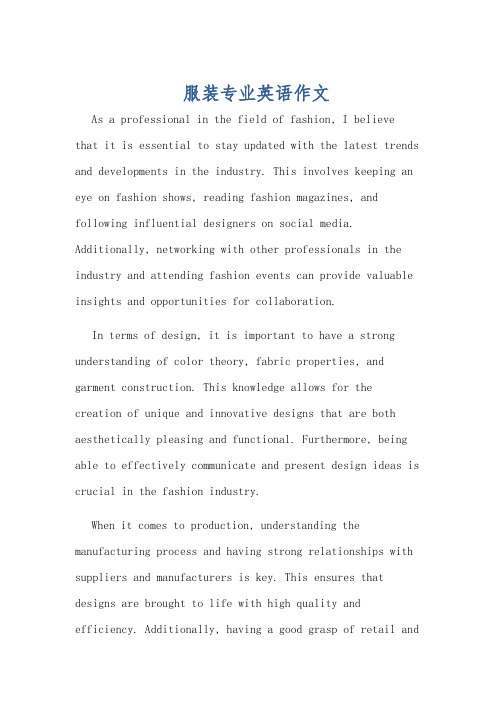
服装专业英语作文As a professional in the field of fashion, I believethat it is essential to stay updated with the latest trends and developments in the industry. This involves keeping an eye on fashion shows, reading fashion magazines, and following influential designers on social media. Additionally, networking with other professionals in the industry and attending fashion events can provide valuable insights and opportunities for collaboration.In terms of design, it is important to have a strong understanding of color theory, fabric properties, and garment construction. This knowledge allows for the creation of unique and innovative designs that are both aesthetically pleasing and functional. Furthermore, being able to effectively communicate and present design ideas is crucial in the fashion industry.When it comes to production, understanding the manufacturing process and having strong relationships with suppliers and manufacturers is key. This ensures that designs are brought to life with high quality and efficiency. Additionally, having a good grasp of retail andmarketing strategies is important for successfullypromoting and selling fashion products.Overall, the fashion industry is fast-paced andconstantly evolving, so it is important to be adaptable and open to new ideas. Keeping a keen eye on consumer behavior and market trends is crucial for success in this industry.作为服装专业的从业者,我认为及时了解行业的最新趋势和发展是至关重要的。
介绍服装的稿子英文作文

介绍服装的稿子英文作文Title: The Art of Fashion: Exploring the World of Clothing。
Fashion is more than just garments; it's an intricate language of expression, culture, and identity. From the ancient civilizations to modern runways, clothing has played a pivotal role in shaping human history. In this essay, we delve into the multifaceted realm of fashion, exploring its evolution, significance, and cultural impact.Evolution of Fashion:Fashion's journey spans millennia, evolving alongside human civilization. From the earliest days of crude garments fashioned from animal hides to the intricate designs of haute couture, clothing has mirrored societal values, technological advancements, and cultural shifts. The evolution of fashion is a testament to human creativity and adaptability, showcasing our ingenuity in transformingbasic necessities into works of art.Significance of Fashion:Fashion serves as a powerful tool for self-expression and communication. The clothes we wear convey messages about our personality, status, and beliefs. Whether consciously or unconsciously, our fashion choices reflect cultural influences, individual preferences, and societal norms. Fashion empowers individuals to express their identity, establish social connections, and assert their place in the world.Moreover, fashion is an industry of immense economic significance, driving innovation, employment, and consumerism. From global fashion houses to local artisans, the fashion industry encompasses a diverse ecosystem of designers, manufacturers, retailers, and consumers. The global fashion market not only fuels economic growth but also shapes trends, influences consumer behavior, and fosters cultural exchange on a global scale.Cultural Impact of Fashion:Fashion serves as a lens through which we can examine the rich tapestry of human culture. Each garment tells a story, reflecting the traditions, values, and aesthetics of its creators and wearers. Cultural attire, such as the vibrant saris of India or the elegant kimonos of Japan, encapsulates centuries of tradition and heritage, servingas symbols of cultural identity and pride.Furthermore, fashion transcends geographical boundaries, serving as a bridge between diverse cultures. Through fashion, we can appreciate the beauty of cultural diversity and celebrate the myriad expressions of human creativity. Fashion weeks, exhibitions, and collaborations provide platforms for cross-cultural dialogue and exchange,fostering understanding and appreciation among people of different backgrounds.Conclusion:In conclusion, fashion is a dynamic and multifacetedphenomenon that permeates every aspect of human society. From its humble origins to its current status as a global industry, fashion continues to evolve, inspire, and captivate. As we navigate the ever-changing landscape of fashion, let us recognize its power to shape our world, influence our perceptions, and unite us in a shared appreciation for beauty and creativity.。
高中英语作文关于服装

高中英语作文关于服装Fashion is an integral part of our daily lives. It is not just about clothing, but also about expressing one's personality and creativity. The way we dress reflects our individuality and sense of style.Clothing serves both functional and aesthetic purposes.It not only protects us from the elements but also allows usto make a statement. Through fashion, we can show ourcultural identity, social status, and personal preferences.Fashion trends are constantly changing, influenced by various factors such as music, art, and culture. It is fascinating how certain styles from the past can make a comeback and become popular once again. Fashion is an ever-evolving form of art, and it reflects the spirit of the times.The fashion industry is a massive global business that encompasses clothing, footwear, accessories, and more. It notonly provides us with the means to express ourselves but also creates job opportunities for designers, tailors, photographers, models, and countless others.Personal style is an important aspect of fashion. Each person has their own unique taste and flair when it comes to dressing. Some prefer a more classic and conservative look, while others may be more drawn to bold and avant-garde pieces. Regardless of individual preferences, fashion allows us to experiment and have fun with our clothing choices.Overall, fashion is a powerful form of self-expressionand creativity. It allows us to showcase our individuality while also connecting us to a broader social and cultural context. Whether through classic styles or cutting-edge trends, fashion continues to inspire and captivate people around the world.。
初二英语服装的作文
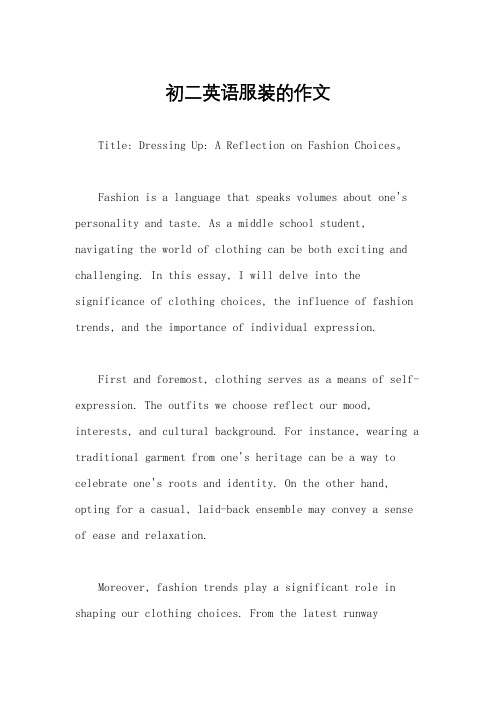
初二英语服装的作文Title: Dressing Up: A Reflection on Fashion Choices。
Fashion is a language that speaks volumes about one's personality and taste. As a middle school student, navigating the world of clothing can be both exciting and challenging. In this essay, I will delve into the significance of clothing choices, the influence of fashion trends, and the importance of individual expression.First and foremost, clothing serves as a means of self-expression. The outfits we choose reflect our mood, interests, and cultural background. For instance, wearing a traditional garment from one's heritage can be a way to celebrate one's roots and identity. On the other hand, opting for a casual, laid-back ensemble may convey a sense of ease and relaxation.Moreover, fashion trends play a significant role in shaping our clothing choices. From the latest runwaydesigns to popular street styles, trends permeate the fashion landscape and influence what we see in stores andon social media. As adolescents, we often feel pressure to conform to these trends, fearing judgment or exclusion ifwe don't adhere to the current fashion norms. However, it's essential to remember that true style transcends trends. Embracing individuality and wearing what makes us feel comfortable and confident is key to cultivating a genuine sense of style.Additionally, the way we dress can impact how others perceive us. In a society where first impressions matter, our clothing choices can shape people's opinions of us before we even utter a word. While it's natural to want to make a positive impression, it's crucial to dress authentically rather than trying to fit into a mold that doesn't align with who we are. By staying true to ourselves, we project confidence and authenticity, which are far more attractive qualities than simply following the latest fashion fads.Furthermore, clothing can also serve as a form ofcreative expression. Experimenting with different colors, patterns, and styles allows us to showcase our personality and artistic flair. Whether we're layering unexpected pieces together or accessorizing with statement jewelry, fashion provides a canvas for self-expression and creativity. It's through this experimentation that we can discover our unique sense of style and develop a signature look that sets us apart from the crowd.In conclusion, clothing plays a multifaceted role in our lives, serving as a form of self-expression, a reflection of current trends, and a means of creative exploration. As middle school students, it's essential to navigate the world of fashion with confidence and authenticity, embracing our individuality rather than succumbing to societal pressures. By understanding the significance of our clothing choices and staying true to ourselves, we can cultivate a sense of style that is uniquely our own.。
服装方面的作文英语
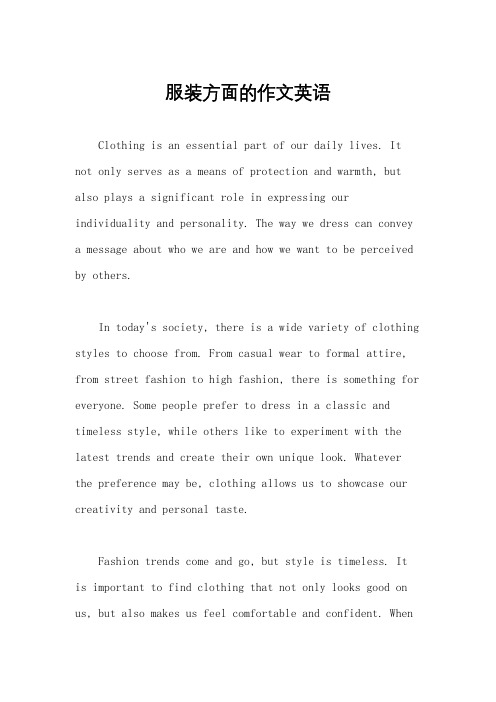
服装方面的作文英语Clothing is an essential part of our daily lives. It not only serves as a means of protection and warmth, but also plays a significant role in expressing ourindividuality and personality. The way we dress can convey a message about who we are and how we want to be perceived by others.In today's society, there is a wide variety of clothing styles to choose from. From casual wear to formal attire, from street fashion to high fashion, there is something for everyone. Some people prefer to dress in a classic and timeless style, while others like to experiment with the latest trends and create their own unique look. Whatever the preference may be, clothing allows us to showcase our creativity and personal taste.Fashion trends come and go, but style is timeless. It is important to find clothing that not only looks good on us, but also makes us feel comfortable and confident. Whenwe feel good in what we wear, it shows in our demeanor and how we carry ourselves. Confidence is key when it comes to fashion, as it can make even the simplest outfit look stylish and put-together.In addition to expressing our personal style, clothing also serves as a form of self-expression. The colors, patterns, and fabrics we choose to wear can reflect our mood, personality, and even our cultural background. For example, someone who wears bright and bold colors may be seen as outgoing and adventurous, while someone who prefers neutral tones may be perceived as more reserved and understated.Furthermore, clothing can also be used to make a statement or send a message. T-shirts with slogans or graphics, for example, can be a way to express our beliefs, values, or sense of humor. Fashion has the power to be a form of activism, as seen in the rise of sustainable and ethical clothing brands that promote social and environmental causes.In conclusion, clothing is more than just something we put on our bodies. It is a form of self-expression, creativity, and communication. By choosing clothing that reflects who we are and how we want to be perceived, we can use fashion as a tool to express ourselves and make a statement to the world. So next time you get dressed in the morning, remember that your outfit is more than just clothes – it is a reflection of you.。
有关服饰的四级英语作文写作

有关服饰的四级英语作文写作英文回答:Fashion is a form of self-expression, a way to communicate our individuality and creativity. It can be a reflection of our culture, our personality, and even our mood. While practicality and comfort are important considerations in clothing choices, the power of fashion goes beyond mere functionality. It has the ability to empower us, to make us feel confident, and to connect us with others.Fashion has the power to transform our appearance and, in turn, our self-perception. When we wear clothing that makes us feel good, it can boost our confidence and mood. This can have a positive impact on our interactions with others and our overall well-being. Fashion can also be a source of empowerment, especially for those who have traditionally been marginalized or excluded. By embracing their own unique style, individuals can challenge societalnorms and express their true identities.Fashion is a powerful tool for communication. It can be used to convey our personality, our beliefs, and our values. Through our clothing choices, we can communicate who we are and what we stand for. Fashion can also be used to connect us with others who share our interests or passions. By wearing similar clothing or accessories, we can create a sense of community and belonging.Fashion is not just about aesthetics. It is also a reflection of our culture and society. The way we dress can provide insights into our history, our values, and our aspirations. Fashion can also be used to promote social and political change. By using clothing as a canvas for expression, activists can raise awareness about important issues and challenge the status quo.The power of fashion is undeniable. It has the abilityto transform our appearance, our self-perception, and our interactions with others. It can be a source of empowerment, communication, and cultural expression. Fashion is morethan just clothing; it is a powerful tool that can shape our lives in countless ways.中文回答:时尚是一种自我表达的形式,是一种传达我们个性和创造力的方式。
服装类的英语文章阅读
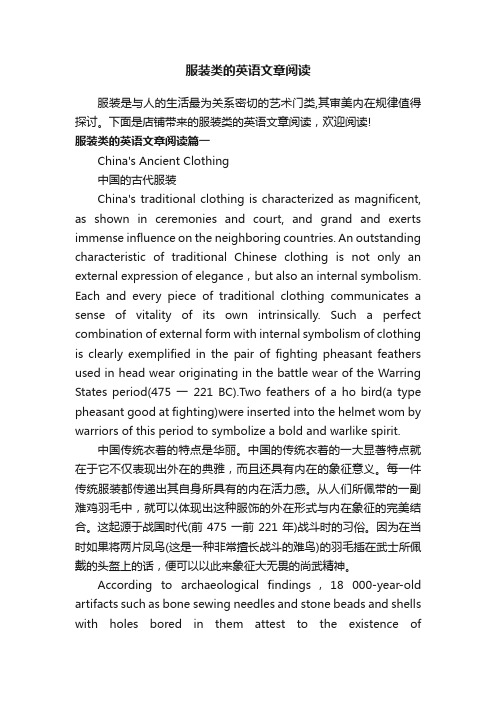
服装类的英语文章阅读服装是与人的生活最为关系密切的艺术门类,其审美内在规律值得探讨。
下面是店铺带来的服装类的英语文章阅读,欢迎阅读!服装类的英语文章阅读篇一China's Ancient Clothing中国的古代服装China's traditional clothing is characterized as magnificent, as shown in ceremonies and court, and grand and exerts immense influence on the neighboring countries. An outstanding characteristic of traditional Chinese clothing is not only an external expression of elegance,but also an internal symbolism. Each and every piece of traditional clothing communicates a sense of vitality of its own intrinsically. Such a perfect combination of external form with internal symbolism of clothing is clearly exemplified in the pair of fighting pheasant feathers used in head wear originating in the battle wear of the Warring States period(475一221 BC).Two feathers of a ho bird(a type pheasant good at fighting)were inserted into the helmet wom by warriors of this period to symbolize a bold and warlike spirit.中国传统衣着的特点是华丽。
服装英语论文

A Comparison of Chinese and WesternClothing Culture【Abstract】In a sense, clothing reflects cultivation, taste, even dignity, and personality. Itdoes not only beautify one's appearance but also represents a national political, economic, scientific, technological, and cultural landscape. In a word, it reflects the nation's overall quality. As one of the human culture manifestations, clothing culture was born to the national difference. This paper has analyzed the difference of Chinese and the Western clothing cultural in many aspects. The innovative spot of the paper is that it uses artistic conception to expatiate the Chinese and the Western clothing cultural differences. It enables people to have further understanding of Chinese and the Western clothing culture, achieving a better inheritance and development.【Key W ords】contrast;clothing;China;west;One Different rank concepts in Chinese and W estern clothing1 Rank concept of clothing in ChinaChina is the nation of etiquette. The goal of the rituals is to maintain “the etiquette has the different ranks”, and clothing is the representation of different ranks. Therefore, the Chinese clothing culture is the symbol of politics. For example, the King always wore the fur coat as sacrificial clothing in the significant festival. The quantity and the quality of the pearls enchased in the crown are different a ccording to the owner’s status. The clothes are not only different in color, but also in the design. The crown of king and the fumigated clothing are decorated by twelve kinds of emblems. The emblems refer to the sun, the moon, the stars, the dragon, the insect; the algae, the fire, and the embroidery on the ceremonial dress of noblemen in ancient times, as well as the unicorn, which have their symbolic significance. The garments of upper duke take nine chapters, but the marquis’ clothing have seven chapters, or five chapters. The reason why people make such a complex stipulation to the clothing is that it can distinguish miscellaneous and simpleness, and classify the senior and junior. When the dynasty changed, especially when another race to invade. It always caused a dramatic revolution in the national clothing.2 Rank concept of clothing in Western countriesThe break of the western culture and the primitive effect are quite thorough. The ancient Greece city-state system demonstrated the characteristic of the slave-owner democratism, whose society had not been controlled by an emperor. Therefore the western clothing rank idea is quite weak and not strict except the extremely special ceremony activity. Upscale works and fine lining mainly display their rank differences. Many noblewomen bribe the clothing artisan in the palace to know what kind of clothing the queen will wear in the social occasion. Then they dress up as the same as their queen, in order to show off. Their queen always permits others to wear the same attire like hers. This tolerant behavior causes little exclusive politics in the clothing, such as design, color, pattern and aesthetic factors.Two The development in modern Chinese clothWith the development of their economic, Chinese fashion designers also use a mixture of traditional and modern ideas to create new fashions. These new fashions also incorporate age-old motifs such as guardian deities, lions, and masks of Chinese opera characters. Many accessories such as macraméare used to decorate shoulders, bodices, pockets, seams, and openings of clothing, as well as belts, hair ornaments, and necklaces. Some successful examples of combinations of modern and traditional fashion elements are the modern bridal tiara, based on a Sung Dynasty design and the Hunan Province style of embroidered sash made in the traditional colors of pure red, blue, and green. From these examples, it can be seen how traditional Chinese dress is the foundation of modern fashion. However, the Chinese have also adopted many Western styles of clothing such as business suits and jeans。
关于服装英文作文
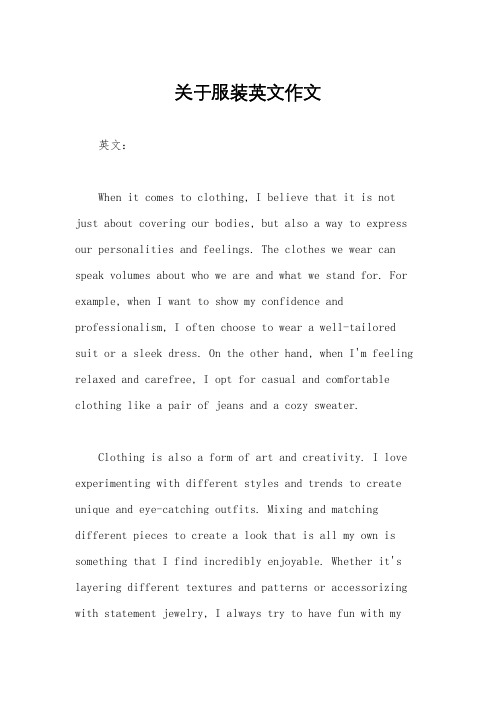
关于服装英文作文英文:When it comes to clothing, I believe that it is not just about covering our bodies, but also a way to express our personalities and feelings. The clothes we wear can speak volumes about who we are and what we stand for. For example, when I want to show my confidence and professionalism, I often choose to wear a well-tailored suit or a sleek dress. On the other hand, when I'm feeling relaxed and carefree, I opt for casual and comfortable clothing like a pair of jeans and a cozy sweater.Clothing is also a form of art and creativity. I love experimenting with different styles and trends to create unique and eye-catching outfits. Mixing and matching different pieces to create a look that is all my own is something that I find incredibly enjoyable. Whether it's layering different textures and patterns or accessorizing with statement jewelry, I always try to have fun with myclothing choices.In addition to self-expression and creativity, clothing also plays a practical role in our lives. It provides us with protection from the elements and helps us feel comfortable in different environments. For example, whenI'm going for a hike, I make sure to wear moisture-wicking clothing that will keep me dry and comfortable. On the other hand, when I'm attending a formal event, I choose clothing that is appropriate for the occasion and makes me feel confident and put-together.中文:对于服装,我认为它不仅仅是为了遮体,更是一种表达我们个性和感受的方式。
关于服装的英文文章.doc
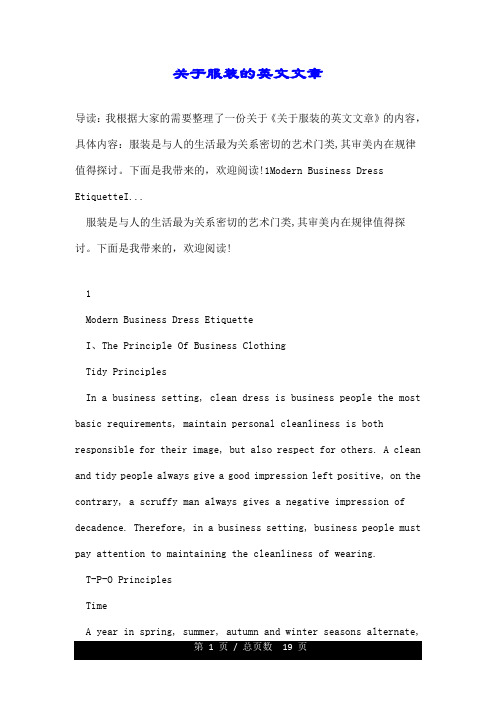
关于服装的英文文章导读:我根据大家的需要整理了一份关于《关于服装的英文文章》的内容,具体内容:服装是与人的生活最为关系密切的艺术门类,其审美内在规律值得探讨。
下面是我带来的,欢迎阅读!1Modern Business Dress EtiquetteI...服装是与人的生活最为关系密切的艺术门类,其审美内在规律值得探讨。
下面是我带来的,欢迎阅读!1Modern Business Dress EtiquetteI、The Principle Of Business ClothingTidy PrinciplesIn a business setting, clean dress is business people the most basic requirements, maintain personal cleanliness is both responsible for their image, but also respect for others. A clean and tidy people always give a good impression left positive, on the contrary, a scruffy man always gives a negative impression of decadence. Therefore, in a business setting, business people must pay attention to maintaining the cleanliness of wearing.T-P-O PrinciplesTimeA year in spring, summer, autumn and winter seasons alternate,and there are changes in morning and evening in one day, at different times, the dress should vary. For example, We wear warm winter clothes in winter, summer clothes in summer. Different time wear differently for women is especially important. Men have a sufficiently fine texture dark suit, while womendress will have to transform over time. Work during the day, women should wear suits to reflect professionalism; night to attend a cocktail party to be adding some modifications, such as for a pair of high heels, wearing shiny accessories, around a beautiful scarf; clothing choices climatic characteristics for the season to keep up with the trend trend synchronization。
关于服装的英语文章阅读
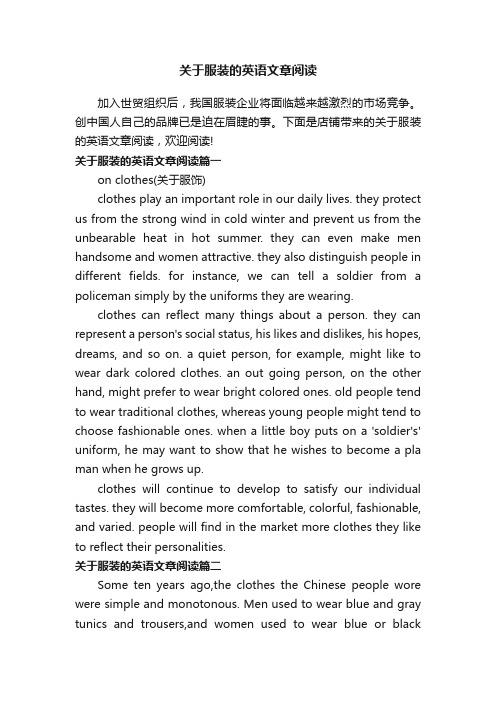
关于服装的英语文章阅读加入世贸组织后,我国服装企业将面临越来越激烈的市场竞争。
创中国人自己的品牌已是迫在眉睫的事。
下面是店铺带来的关于服装的英语文章阅读,欢迎阅读!关于服装的英语文章阅读篇一on clothes(关于服饰)clothes play an important role in our daily lives. they protect us from the strong wind in cold winter and prevent us from the unbearable heat in hot summer. they can even make men handsome and women attractive. they also distinguish people in different fields. for instance, we can tell a soldier from a policeman simply by the uniforms they are wearing.clothes can reflect many things about a person. they can represent a person's social status, his likes and dislikes, his hopes, dreams, and so on. a quiet person, for example, might like to wear dark colored clothes. an out going person, on the other hand, might prefer to wear bright colored ones. old people tend to wear traditional clothes, whereas young people might tend to choose fashionable ones. when a little boy puts on a 'soldier's' uniform, he may want to show that he wishes to become a pla man when he grows up.clothes will continue to develop to satisfy our individual tastes. they will become more comfortable, colorful, fashionable, and varied. people will find in the market more clothes they like to reflect their personalities.关于服装的英语文章阅读篇二Some ten years ago,the clothes the Chinese people wore were simple and monotonous. Men used to wear blue and gray tunics and trousers,and women used to wear blue or blackblouses and skirts. When you were in some public places, you seemed to be in a forest of trees of the same kind in the same colour and appearance.But now people have changed their custom in their clothing. Men begin to look for clothes which make them look more handsome;while women begin to dress themselves mor beautifully. When you are in a crowd of people,you seem to be in a garden of colourful flowers.This change is the result of the policy of reform and opening up to the outside world in China. People dare to wear what they like to. And they become richer than before and can afford the varieties of clothes they want. They have no fear that they would be called bourgeois.大约十年前,中国人穿的衣服很简单和单调。
- 1、下载文档前请自行甄别文档内容的完整性,平台不提供额外的编辑、内容补充、找答案等附加服务。
- 2、"仅部分预览"的文档,不可在线预览部分如存在完整性等问题,可反馈申请退款(可完整预览的文档不适用该条件!)。
- 3、如文档侵犯您的权益,请联系客服反馈,我们会尽快为您处理(人工客服工作时间:9:00-18:30)。
服装英语论文文章一Change Of Chinese ClothingTraditionAn outstanding characteristic of traditional Chinese clothing is not only an external expression of elegance, but also an internal symbolism. Each and every piece oftraditionalclothing communicates a vitality of its own. This combination of external form with internal symbolism is clearly exemplified in the pair of fighting pheasant feathers used in head wear originating in the battle wear of the Warring States period (475-221 B.C.). Two feathers of a ho bird (a type pheasant good at fighting) were inserted into the head wear of warriors of this period to symbolize a bold and warlike spirit.Archaeological findings of 18,000 year-old artifacts such as bone sewing needles and stone beads and shells with holes bored in them attest to the existence of ornamentation and of sewing extremely early in Chinese civilization. Variety and consistency in clothing were roughly established by the era of the Yellow Emperor and the Emperors Yao and Shun (about 4,500 years ago). Remains of woven silk and hemp articles and ancient ceramic figures further demonstrate the sophistication and refinement of clothing in the Shang Dynasty (16th to 11th century B.C.).The three main types of traditional Chinese clothing are the pien-fu, the ch'ang-p'ao, and the shen-i. The pien-fu is an ancient two-piece ceremonial costume of a tunic-like top extending to the knees and a skirt or trousers extending to the ankles. The ch'ang-p'ao is a one-piece garment extending from the shoulders all the way to the heels. The shen-i is a cross between the pien-fu and the ch'ang-p'ao; it consists of a tunic and a skirt or trousers like the pien-fu, but the tunic and the skirt are sewed together and essentially one piece like the chang-pao. Consequently, the shen-i was the most widely worn of the three types. Typical of these three types of clothing were wide and voluminous sleeves and a very loose fit. Tunic and trousers or tunic and skirt, utilized a very minimum number of stitches for the amount of cloth used. So because of their relatively plain design and structure, embroidered edgings, decorated bands, draped cloth or silks, patterns on the shoulders, and sashes were often added as ornamentation. These varied designs came to be one of the unique features of traditional Chinese dress.Darker colors were favored over lighter ones in traditional Chinese clothing, so the main color of ceremonial clothing tended to be dark while bright, elaborate tapestry designs accented. Lighter colored clothing was worn more frequently by the common people for everyday and around the house use. The Chinese associate certain colors with specific seasons: green represents spring, red symbolizes summer, white represents autumn, andblack symbolizes winter. The Chinese are said to have a fully developed system of matching, coordinating, and contrasting colors and shades of light and dark in apparel.TodayToday, Fashion designers use a mixture of traditional and modern ideas to create new fashions. These new fashions also incorporate age-old motifs such as guardian deities, lions, and masks of Chinese opera characters. Chinese bronze is another source of printed, woven, embroidered, and applied design for clothes. Some of the distinctive designs include dragons, phoenixes, clouds, and lightning. Motifs from traditional Chinese painting also end up in woven or printed fashion designs.In modern society, men are seen at social occasions wearing the dignified and refined traditional Chinese long gown, and women often wear the ch'i-p'ao, a modified form of a traditional Ching Dynasty fashion, on formal occasions. The variations of height, length, width, and ornamentation of the collar, sleeves, skirt, and basic cut of this Oriental fashion are limitless.Many accessories such as macram?are used to decorate shoulders, bodices, pockets, seams, and openings of clothing, as well as belts, hair ornaments, and necklaces. Some successful examples of combinations of modern and traditional fashion elements are the modern bridal tiara, based on a Sung Dynasty design and the Hunan Province style of embroidered sash made in the traditional colors of pure red, blue, and green. From these examples, it can be seen how traditional Chinese dress is the foundation of modern fashion. However, the Chinese have also adopted many Western styles of clothing such as business suits and jeans.文章二A Comparison of Chinese and WesternClothing Culture【Abstract】In a sense, clothing reflects cultivation, taste, even dignity, and personality. Itdoes not only beautify one's appearance but also represents a national political, economic, scientific, technological, and cultural landscape. In a word, it reflects the nation's overall quality. As one of the human culture manifestations, clothing culture was born to the national difference. This paper has analyzed the difference of Chinese and the Western clothing cultural in many aspects. The innovative spot of the paper is that it uses artistic conception to expatiate the Chinese and the Western clothing cultural differences. It enables people to have further understanding of Chinese and the Western clothing culture, achieving a better inheritance and development.【Key Words】contrast;clothing;China;west;I. IntroductionClothing is a mundane part of our daily life. Yet in every culture, clothing is one of the most powerful and ubiquitous forms of visual communication. Judging people's clothes they wear, we can easily evaluate their social status, occupation, ethnic or national identity, and so on. Manipulating the same sets of signals, people can declare their individuality, indicate their beliefs, and signify their membership within various groups through the way they dress. Clothing is human unique achievement. It is not only the material civilized crystallization, but also the meaning of spiritual civilization. The h uman passed through society from barbarism to the civilization, marched forward slowly for several thousand years. After our ancestors left the apes and monkeys with a hands-clasped bow, they draped over the animal skin and the leaf to go through the years in wind and rain which counted with difficulty, and finally strode in the civilized time difficultly. Then they got to warm the body by leaves, created a material civilization. However, to pursue beauty is the human instinct. The clothes on human as the gold plating in Buddha, whose aim is not only to cover and warm body, but also to make them look more beautiful. After the appearance of clothing, people gradually put their custom, esthetic appeal, color interest, as well as all sorts of cultural mind, and the religious idea into the clothing, to reflect the connotation of clothing culture. Therefore a nationality's clothing characteristic is deeply rooted in national culture. The Chinese and Western clothing went through the millennium history continually, and then formed their own special style and system.2. Different rank concepts in Chinese and Western clothing2.1 Rank concept of clothing in ChinaChina is the nation of etiquette. The goal of the rituals is to maintain “the etiquette has the different ranks”, and clothing is the representation of different ranks. Therefore, the Chinese clothing culture is the symbol of politics. For example, the King always wore the fur coat as sacrificial clothing in the significant festival. The quantity and the quality of the pearls enchased in the crown are different a ccording to the owner’s status. The clothes are not only different in color, but also in the design. The crown of king and the fumigated clothing are decorated by twelve kinds of emblems(帝王冕服,云衣熏裳,用十二章纹). The emblems refer to the sun, the moon, the stars, the dragon, the insect; the algae, the fire, and the embroidery on the ceremonial dress of noblemen in ancient times, as well as the unicorn, which have their symbolic significance. The garments of upper duke take nine chapters, but the marquis’ clothing have seven chapters, or five chapters. The reason why people make such a complex stipulation to the clothing is that it can distinguish miscellaneous and simpleness, and classify the senior and junior. When the dynasty changed, especially when another race to invade. It always caused a dramatic revolution in the national clothing.2.2 Rank concept of clothing in Western countriesThe break of the western culture and the primitive effect are quite thorough. The ancient Greece city-state system demonstrated the characteristic of the slave-owner democratism, whose society had not been controlled by an emperor. Therefore the western clothing rank idea is quite weak and not strict except the extremely special ceremony activity. Upscale works and fine lining mainly display their rank differences. Many noblewomen bribe the clothing artisan in the palace to know what kind of clothing the queen will wear in the social occasion. Then they dress up as the same as their queen, in order to show off. Their queen always permits others to wear the same attire like hers. This tolerant behavior causes little exclusive politics in the clothing, such as design, color, pattern and aesthetic factors.3. The different culture Of WesternersCan we comprehend our society by observing the appearance and behavior of its people because of the way people dress reveals people's attitudes and interests ? While when we view this fantastic world , we will realize this point of view is reasonable, For instance: the French dress romantically because romance and imagination are the main factors in French culture; the American dress optionally which is the result of American's quick rhythm of life and the Japanese dress formally, which may partly because the emphasizing of comity in Japanese culture. Thus,when we carefully appreciate different dresses from different countries, we can realize distinct cultural atmosphere. Also, changing in people's dressing styles coincide with value changes of a society. A quite typical instance is Artistic Dress Movement happened in 1860s, which were fashion trends in nineteenth century clothing. Dresses were loosely fitted and comparatively plain, often with long puffed sleeves; they were made from fabric in muted colors derived from natural dyes, and could be ornamented with embroidery in the art needlework style. Artistic Dress gradually became popular in intellectual circles and among artist for it natural beauty, it also reinforce their social ideals of quality materials , respect for the work of hands, and the purity of medieval design. Such evidence demonstrate the truth that dress and appearance of people are the mirror of an age.The development in modern Chinese clothWith the development of their economic, Chinese fashion designers also use a mixture of traditional and modern ideas to create new fashions. These new fashions also incorporate age-old motifs such as guardian deities, lions, and masks of Chinese opera characters. Many accessories such as macraméare used to decorate shoulders, bodices, pockets, seams, and openings of clothing, as well as belts, hair ornaments, and necklaces. Some successful examples of combinations of modern and traditional fashion elements are the modern bridal tiara, based on a Sung Dynasty design and the Hunan Province style of embroidered sash made in the traditional colors of pure red, blue, and green. From these examples, it can be seen how traditional Chinese dress is the foundation of modern fashion. However, the Chinese have also adopted many Western styles of clothing such as business suits and jeans。
